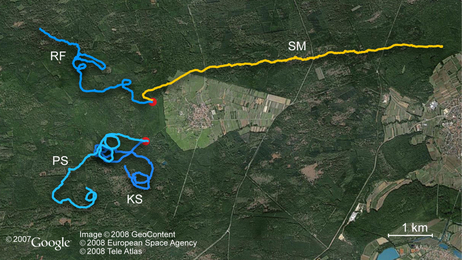Just Keep Swimming…

Finding Nemo's Marlin
In Disney/Pixar’s “Finding Nemo,” Marlin and Dory are swimming through murky waters en route to Sydney Harbor. Marlin suddenly exclaims, “Wait, I have definitely seen this floating speck before. That means we’ve passed it before and that means we’re going in circles and that means we’re not going straight!” – and he is probably right.
Is it really possible that when we cannot see where we are going, we actually travel in circles? Souman et al. tested this belief through a variety of experiments. They found in all cases that when deprived of a visual stimulus, it is actually impossible to travel in a straight line.
The first set of experiments had participants travel through a wood without visual impediments (such as blindfolds). One set of subjects traveled through the woods when it was cloudy, the second set when it was sunny. All of the cloudy group walked in circles and walked in areas that they had previously been, without noticing they had crossed a previous path. In contrast, all of the subjects who could see the sun were able to maintain a course that was relatively straight and had no circles.
The experiment was also performed on blindfolded subjects in an open field.

Paths of Blindfolded Subjects
The blue paths correspond to the subjects that walked on cloudy days. Their paths are mostly curved with many circles. The small straight areas of walking are most likely caused by the setup of the trial – participants walked for a period of time, then were unblindfolded and allowed to walk to the starting point of the next walking block. Even so, when blindfolded, lack of a visual stimulus when blindfolded always resulted in walking in curved motions or in circles. This contrasts the yellow path; this subject walked on a sunny day, and maintained a straight course for a long distance.
What causes this strange phenomenon? Could it perhaps be subtle differences in leg length that introduce a bias to walk in one direction, thus accounting for the circular motion? Nope – the circle directions were still random. Adding shoe soles to add a more than subtle difference in leg length didn’t make a difference: the participants continued to walk in random circles.
Perhaps the only explanation is that our vision is so necessary for our daily lives that our body randomizes without it. This idea is demonstrated in studies in which subjects are kept in a room with constant lighting: their biological clocks become completely randomized with no night and day inputs. More studies should be performed to truly understand the importance of the visual system. Since we rely so heavily on vision, is it natural for movements to become randomized without it? Do those who are blind from birth experience the same walking in circles phenomenon? For now, the conclusion here is that the sensory systems are complex and there is still much work to be done in understanding this strange phenomenon. So, if you ever find yourself lost in murky Australian waters, you probably should not just keep swimming, but rather, ask a friendly passing whale for directions.
A Mystery: Why Can’t We Walk Straight? : Krulwich Wonders… – NPR
Walking Straight into Circles – Current Biology